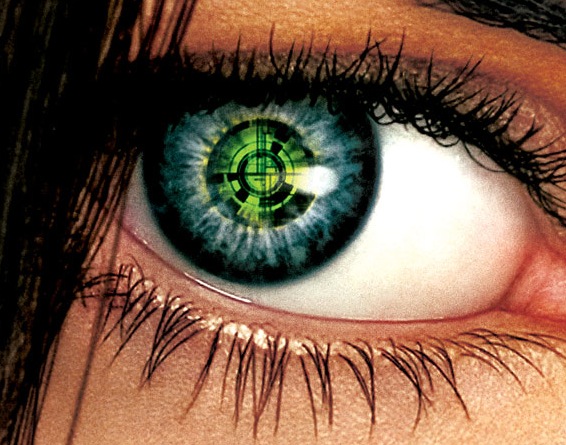

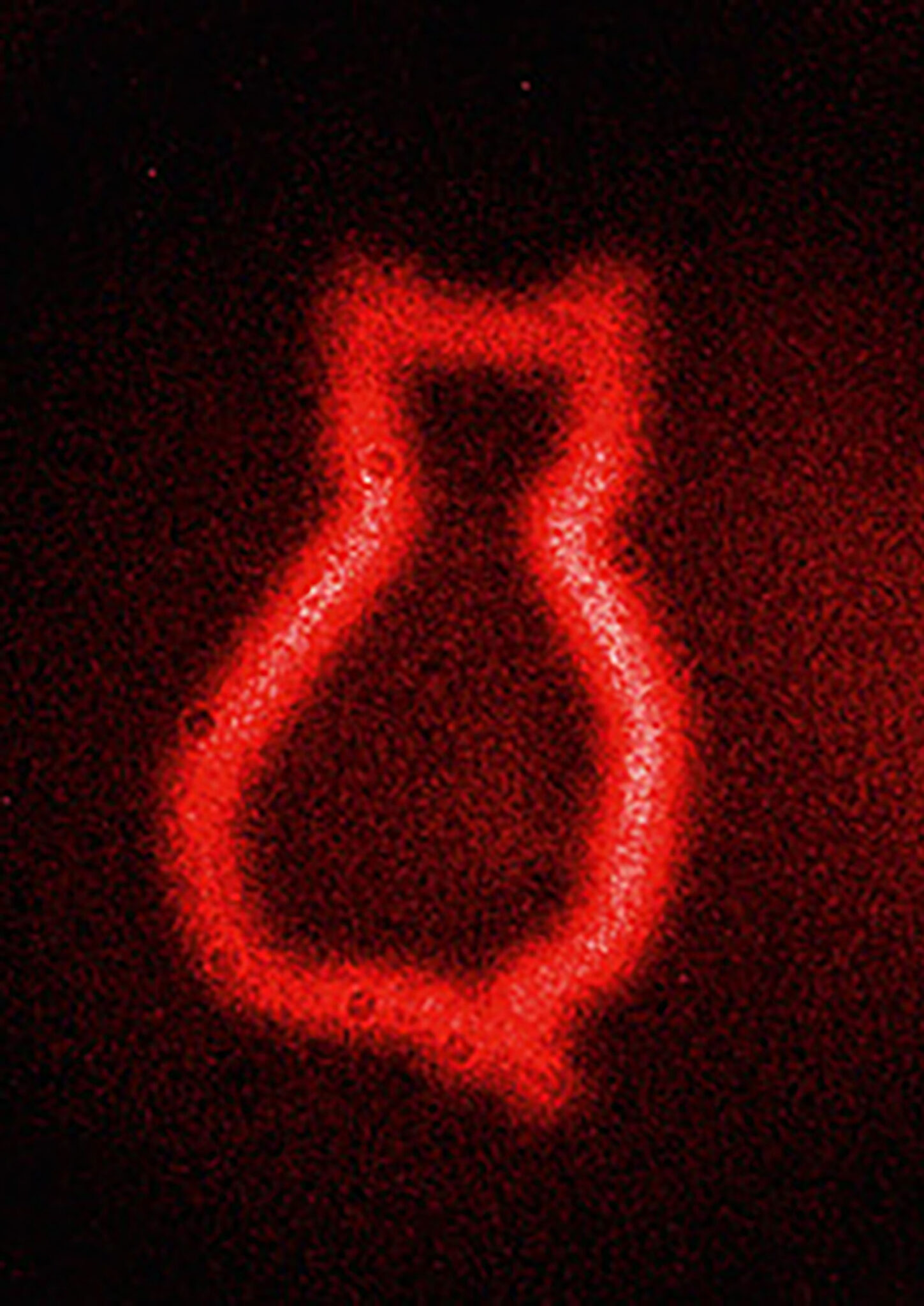
QUBIT AI: Gabriela Barreto Lemos
Quantum Photography
FILE 2024 | Quantico
International Electronic Language Festival
Gabriela Barreto Lemos – Quantum Photography – Brazil
Quantum photography technique that allows you to record images without light passing through the object.
Typically, a beam of light interacts with an object; In this same beam, the image of that object is formed, which is recorded on a camera, on paper or directly into the eye. This research used two quantumly entangled photon beams. An infrared photon was directed at a silicon wafer engraved with the image of a cat. The other photon, red, was sent on a different trajectory, did not pass through the silicon plate and was detected by an EMCCD (electron-multiplying charge-coupled device – a photographic camera with sensitivity to very low intensity light). The image of the cat engraving was recorded by the camera, which only detected the red light, which did not touch the engraving. It is the first time that an image has been captured in a beam of light that has not interacted with the object that produced the image.
The experiment, led by researcher Gabriela Barreto Lemos, was carried out at the Institut für Quantenoptik und Quanteninformation in Vienna, 2014.
The technique has potential for applications in indirect image capture, from medicine to quantum computing.
Bio
Professor at the Federal University of Rio de Janeiro, in Brazil, whose research focus is on quantum optics, with an emphasis on quantum foundations, quantum images and quantum information. Additionally, she is involved in interdisciplinary creative projects and promoting inclusion and diversity in science.
Credits
Gabriela Barreto Lemos
Vienna Center for Quantum Science and Technology
Institut für Quantenoptik und Quanteninformation
Group of Anton Zeilinger

HITO STEYERL
태양의 공장
2015년 베니스 비엔날레 독일관에서 데뷔한 이 몰입형 작품에서 슈타이얼은 전례 없는 글로벌 데이터 흐름으로 정의되는 순간에 이미지 순환의 즐거움과 위험을 탐구합니다. 뉴스 보도, 다큐멘터리 영화, 비디오 게임, 인터넷 댄스 비디오 등 장르 간 충돌 – 태양의 공장은 빛과 가속을 모티브로 감시가 점점 더 가상의 일상적인 부분이 되었을 때 집단 저항에 여전히 사용할 수 있는 가능성을 탐구합니다. 세계. 태양의 공장은 모션 캡처 스튜디오의 강제 이동이 인공 햇빛으로 변하는 노동자의 초현실적 인 이야기를 전합니다.
.
Fábrica del sol
En este trabajo inmersivo, que debutó en el Pabellón Alemán de 2015 en la Bienal de Venecia, Steyerl explora los placeres y peligros de la circulación de imágenes en un momento definido por el flujo global de datos sin precedentes. Rebotando entre géneros (reportajes de noticias, películas documentales, videojuegos y videos de baile en Internet), Factory of the Sun utiliza los motivos de la luz y la aceleración para explorar qué posibilidades están todavía disponibles para la resistencia colectiva cuando la vigilancia se ha convertido en una parte mundana de una realidad cada vez más virtual. mundo. Factory of the Sun cuenta la historia surrealista de trabajadores cuyos movimientos forzados en un estudio de captura de movimiento se convierten en luz solar artificial.

Tobias Putrih
A, H, O, I, ! …
在视觉艺术与建筑之间不断变化的边界上,托比亚斯·普特里赫(Tobias Putrih)的结构可以满足建筑程序的需求,可以代表艺术品本身,也可以作为其他作品的展示。参考文献的融合意味着,在所有情况下,他的作品都通过提及1960年代的建构主义项目和短暂建筑,或者通过与包含现代建筑的纯净几何结构的对比,唤起了20世纪对现代性的某种记忆。与电影及其设备的关系加强了这种空间实验,这是电影形式所指的同一现代性的重要里程碑。在露台上Putrih拥有无形的皮肤,其视频投影空间采用模块化的木材和纸板结构,其线条灵感来自奥斯卡·尼迈耶(Oscar Niemeyer)设计的Palácioda Alvorada的柱子。除了向巴西利亚致敬之外,艺术家还进行了遮盖过程,其中宫殿的清晰而灿烂的支撑点被复杂的皮肤覆盖,这些皮肤重申并抵制了整体的轻盈,使保护性皮肤成为对象沉思的。

Thijis Biersteker
Pollutive Ends
With the art installation Pollutive Ends the artist Thijs Biersteker shows the impact of 1 cigarette butt on our environment and waters. The impact is made visible by moving small elements of real polluted water hypnotically right in front of the visitors eyes through an intricate tube system. The algorithmic driven pumping system calculates the amount of visitors that are in the museum, the likelihood that they smoke and the amount of pollution that they would generate.

Michael Hansmeyer
Subdivided Cube 4
At best, a computational approach enables architecture to be embedded with an extraordinary degree of information. Structure and surface can exhibit a hyper-resolution, with seemingly endless distinct formations. The processes can generate highly specific local conditions, while ensuring an overall coherency and continuity. As such, the resulting architecture does not lend itself to a visual reductionism. Rather, the procedures can devise truly surprising topographies and topologies, offering a thousand unique perspectives. Computational architecture can defy classification, it can evoke curiosity and elicit individual interpretations. The projects presented here forecast an exuberant architecture in which the exceptional supersedes the standard.

HITO STEYERL
Factory of the sun
In this immersive work, which debuted at the 2015 German Pavilion at the Venice Biennale, Steyerl probes the pleasures and perils of image circulation in a moment defined by the unprecedented global flow of data. Ricocheting between genres—news reportage, documentary film, video games, and internet dance videos—Factory of the Sun uses the motifs of light and acceleration to explore what possibilities are still available for collective resistance when surveillance has become a mundane part of an increasingly virtual world. Factory of the Sun tells the surreal story of workers whose forced moves in a motion capture studio are turned into artificial sunshine.

Hito Steyerl
Power Plants
Hito Steyerl’s series of projects at the Serpentine Galleries is positioned around ideas of ‘power’. Beginning from the premise that ‘power is the necessary condition for any digital technology’, the artist considers the multiple meanings of the word, including electrical currents, the ecological powers of plants or natural elements, and the complex networks of authority that shape our environments. She addresses the notion of power through three interrelated research strands and projects: Actual Realityos, a collectively-produced digital tool; Power Walks, a series of guided walks and a tour that draws upon conversations with campaigners, community groups and organizations in the local area surrounding the Serpentine, and finally this exhibition, Power Plants, which features new video installations created using artificial intelligence trained to predict the future.

superbien studio
siderea
We presented our interpretation of a gravitational anomaly, entitled Siderea, an unknown force at the outer fringes of the Universe, in the centre of the Great Attractor. Beyond anything our eyes or our minds are capable of imagining and using geometric and scientific coordinates to create a palpable world to scale, we wanted to tell a deeply immersive tale exploring the emotions that the discovery of such a stellar phenomenon might rouse. Freely inspired by the explorations and incredible advances made in astronomy, we transformed the venue into the point of observation of this extraordinary celestial body, in the literal sense of the term.

Pedro Reyes
Return to Sender
Disarm music box
For the work group Disarm, he was able to use 6,700 weapons confiscated in the Mexican drug war and transform these into musical instruments[…] They play well-known, classical music pieces from the respective manufacturer’s country of origin. A musical box made with Glock pistol parts plays Mozart, Beretta barrels Vivaldi, while Reyes’s weapon of choice for Swiss songwriter Mani Matter is the Carabine. Reyes is concerned with «upcycling» – transforming an instrument of death into a musical instrument that stands for dialog and exchange. He undertakes this transformation process with the conviction that the physical act is always accompanied by an idealistic one and appeals to the spiritual dimension of this quasi-alchemical operation towards the good.

Agnes Meyer-Brandis
Cloud Core Scanner
Her current installation IN THE TROPOSPHERE LAB provides insights into the material produced under conditions distant from earth. The exhibition tells of the formation of clouds and shows conditions and combinations of art and science during zero gravity. With the exhibition by Agnes Meyer-Brandis, the project space of the Ernst Schering Foundation once again presents a contemporary art project that stimulates interdisciplinary debate and builds bridges to scientific research. The lab as a gravimetric document of the “Cloud Core Scanner” experiment shows a world alternating between controlled and bound-less states – artistic research in search of the reality level of constructions of the matter that surrounds us.

adi meyer
Aposema:Responsive Facial Prosthesis
In an age of emotion recognition algorithms and augmented realities, our overuse of personal devices and social media, has led to a society where people increasingly choose technological alternatives to meaningful in-person interaction. Our ability to read facial expressions is severely reduced, limiting our capacity to develop relationships and leaving us struggling to empathize.
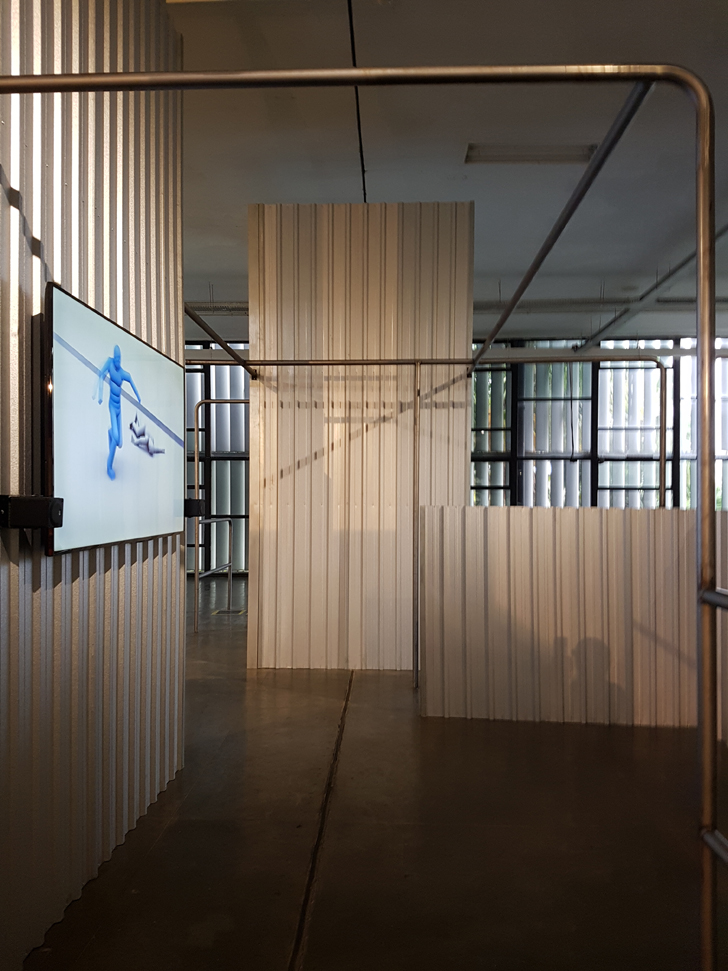
hito steyerl
Robots today
32ª Bienal de São Paulo
Hito Steyerl was born in Munich in 1966. She studied in Tokyo, Munich, and Vienna before she moved to Berlin, where she lives and works today. As a filmmaker, visual artist, and author in the field of essayist documentary video, Steyerl is a frequent lecturer, has published influencial writings, and participated in numerous international exhibitions and biennials. She exhibited at documenta 12 in 2007 and in the German Pavilion at the Venice Biennale 2015.

NIEMEYER CENTER
Avilés, Asturias
The Oscar Niemeyer International Cultural Centre or Centro Niemeyer (Spanish: Centro Cultural Internacional Oscar Niemeyer), (popularly known as el Niemeyer), is the result of the combination of a cultural complex designed by the Brazilian architect Oscar Niemeyer and an international cultural project. The center is located on the estuary of Avilés, Asturias (Spain). It was inaugurated on 26 May 2011.


Hypersonic and Plebian Design
Constructive Interference
Created as a collaboration between Hypersonic and Plebian Design, Constructive Interference is a sculpture designed to engage passer-bys using the wonder of moire patterns. Installation is composed of two large patterned sheets of steel, designed to create a rapidly changing visual interference effect as viewers pass by.Moving shapes and hidden structures appear fleetingly within the sculpture as the eye and body pass by. The effect and shape of the piece changes dramatically from one vantage point to another around the space, while the sculpture itself remains static.
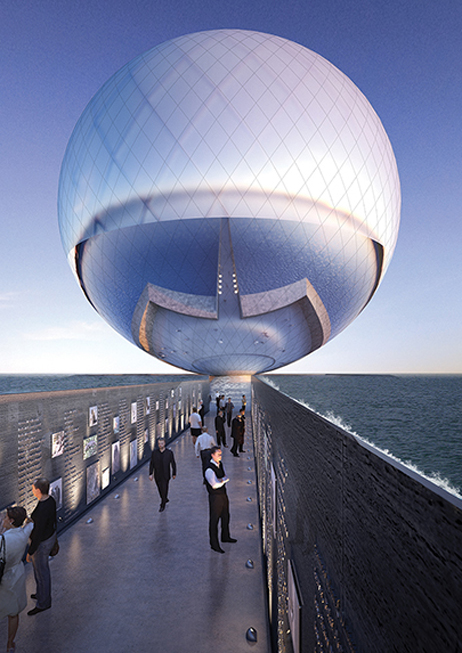
jaesik lim, ahyoung lee, jaeyeol kim and taegu lim
clear orb
“The sustainable architectural culture that aspires the coexistence of human, nature and the architecture itself” is a core value of Heerim Architects and Planners in South Korea, the team behind a sparkling orb designed for Santa Monica Pier. A finalist in the biennial site-specific 2016 Land Art Generator Initiative design competition, which promotes the uptake of energy-generating public art that informs, delights, and uplifts communities and visitors, The Clear Orb reveals a playful approach to holistic design. Using transparent luminescent solar concentrators, the installation is purportedly capable of producing up to half-a-million gallons of fresh water each year for California.
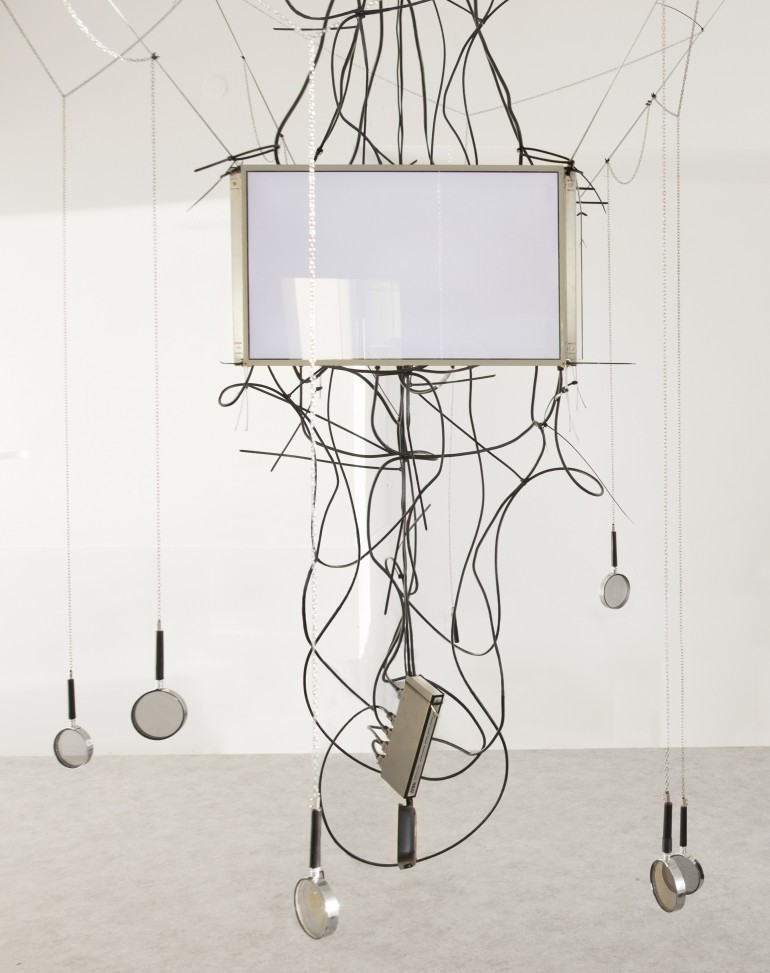
KARINA SMIGLA-BOBINSKI
SIMULACRA
file festival
“SIMULACRA” is an optophysical experimental arrangement. At its heart are four LCD monitor panels, which are assembled in the form of a hollow square, and installed at eye level in the middle of the room. The ensemble appears internally gutted, overgrown and embraced. A tangle of cables and control devices pours out of the middle of the square. All around it several magnifying lenses dangle from chains. The imageless glaring ray of the monitors looks as if the images had fallen out of them. What remains is the essence of the medium: Light.It is an impressive, wondrous experience when images suddenly appear from the pure white by the mere glance through a seemingly transparent film. But if you turn the lens in front of your eyes, the polarizing structure of the film creates wild color shifts or even complementary negative images.


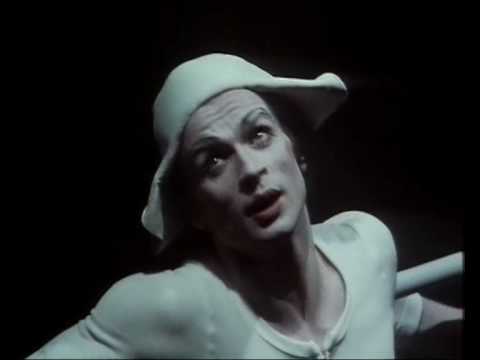
RUDOLF NUREYEV
Pierrot Lunaire
In his desire to expand his art to other forms of dance, Rudolf Nureyev performed this choreography by Glen Tetley many times and in many countries, and included it in the repertoire of his “Nureyev and Friends”.
He identified with this tragic character as with Fokine’s Petrouchka, another of his favourite roles. Glen Tetley resisted during five years before giving him this choreography, fearing that the intense personality of the dancer would overwhelm the innocence of Pierrot, but Rudolf revealed a deep vulnerability in this role. While he was rehearsing Pierrot lunaire with Tetley, he was being filmed in Valentino, and had started to choreograph his version of Romeo and Juliet. It is just an example of the extraordinary density and variety of his schedules. Martine Kahane
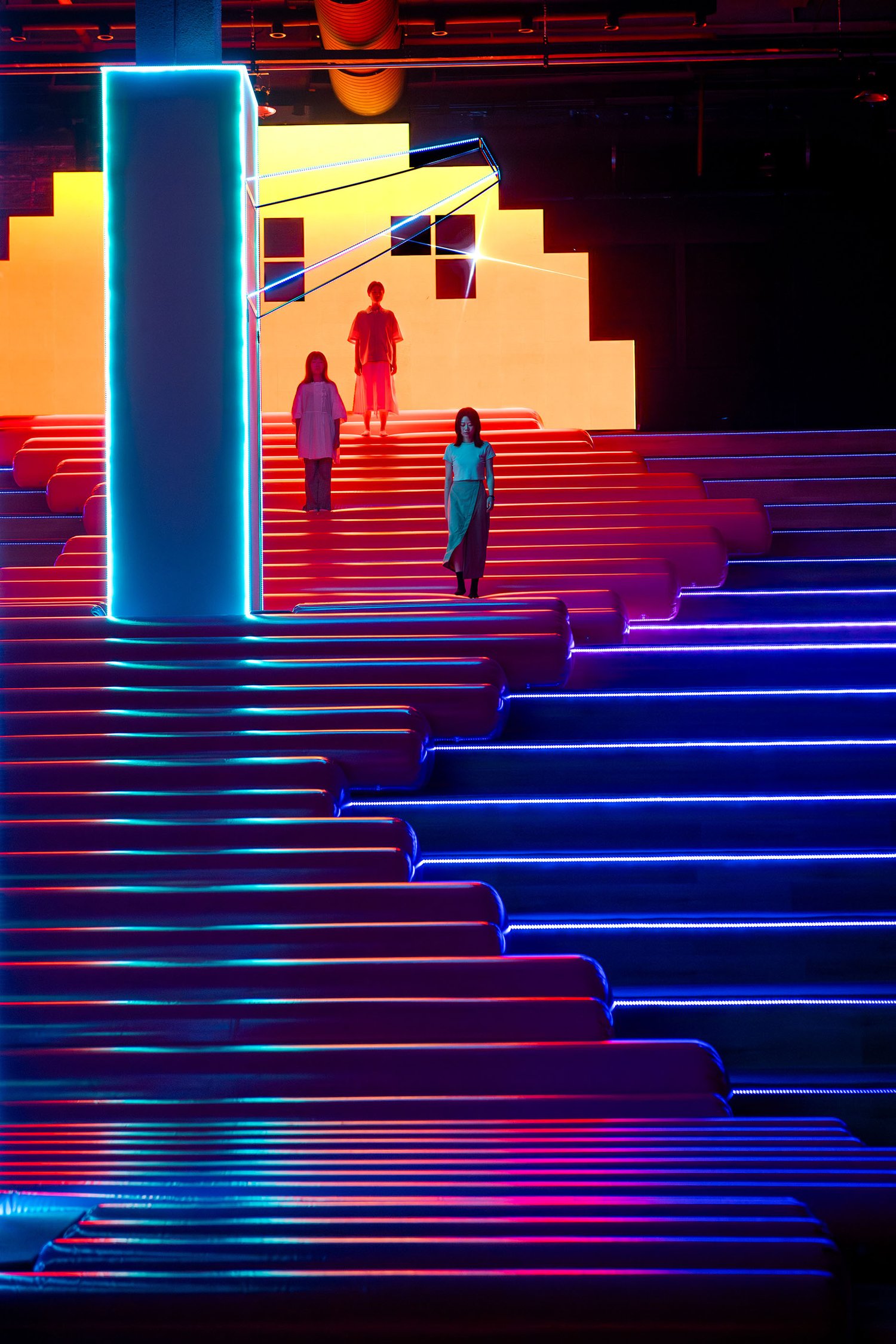
ENESS
Modern Guru
Modern Guru is a translucent ovoid with four huge digital eyes, floating above a ceremonial ring of LEDs. From his mouth flows a ream of absurdist messages, and in a statement about the true nature of lived experience, a new message is delivered when visitors take a photo of Modern Guru – a missive produced only for those who seek to photograph life rather than live the moment. This immersive new media art installation uses the intersection of art and technology to explore modern paths to happiness through unique interactions with characters along a mystical journey of discovery. Visitors are asked to commit to the path – a tight and winding trail with subtle points of connection along the way – a glowing landscape of oversized, whimsical mountains that chant incantations and blink innocently from digital eyes.
Having communed with the Guru, visitors then weave their way back through this warped and strange world full of illusions and delusions, perceptions and deceptions, all the while bathing in luminescent light; embracing big, gentle forms; and following their own path up the pink tongue staircase to meet the one who oversees the whole fantastic dominion, the Sun God.

Sharon Eyal
Soul chain
“La pièce qui semble inspirée d’un numéro de music-hall ou de cabaret qu’elle pervertit aussitôt ne cherche pas l’élégance, ne tire pas vers la séduction aguicheuse et facile. Le geste est moins poli. Il déjoue les attentes et se moque des apparences. Le groupe transpire en permanence d’un irrépressible désir de résistance et de transgression, d’autant d’états, de sentiments intérieurs que Sharon Eyel et ses danseurs cherchent à extraire, à faire s’extirper et se libérer des corps qui exultent dans l’urgence.” Christophe Candoni
.
Salt Womb
“Laut Programm bewegt sich die Ballett-Compagnie in „Salt Womb“ als Ganzes wie eine Maschine. Und wirklich: im 1. Bild dieses Stückes mit dem enigmatischen Titel stehen die Tänzer und Tänzerinnen des Basler Balletts in einem großen Halbkreis, der zu Ende gedacht wie ein Zylinder wirkt, in dessen Mitte sich ein riesiger Kolben auf und ab bewegt. Die Körper der Tänzer:innen, die sich breitbeinig stehend immer wieder auf und ab bewegen, wirken wie gefangen in einem nicht enden wollenden Kraftakt: die minutenlange, fast stoische Wiederholung einer einzigen Bewegung zu hämmernden Technobeats hat tatsächlich etwas Inhumanes… Nach und nach formieren sie sich zu einer pulsierenden Gruppe in Dauerbewegung, zu einem unheimlich wirkenden Superorganismus, aus dem sich einzelne Tänzer:innen in kurzen Solopassagen herauslösen, aber immer wieder vom Sog des Gruppenpulses aufgesogen werden.” Renate Killmann

Doug Aitken
The Garden
The Garden is a living artwork that embraces the dichotomy between the natural environment and a synthetic man-made experience. Aitken’s The Garden installation brings the viewer into the center of the artwork and asks them to physically immerse, participate and become the subject of the installation. Set inside a dark warehouse space the viewer walks inside, their eyes adjusting to become aware of thick lush jungle growing under artificial grow lights. Walking closer, the viewer enters inside the jungle and discovers a huge rectangular glass cube. Inside the glass room is a man-made environment replete with generic elements of modern life: tables and chairs, a cabinet, a sterile tableau set under bright raking lights.

SpY
ORB
The shape of the piece alludes to the ‘pi’ number concealed in the geometry of the Pyramids, found when dividing the perimeter of a Pyramid by twice its height. The sphere is an invisible part of the resulting geometry, since a sphere with a radius as high as the Pyramid would have a circumference very close in length to the Pyramid’s perimeter. The surface of the artwork captures the Pyramids, the sky, the surroundings and the viewers in a multiple fragmented reflection. It references the role of the circular mirror in historical Egyptian symbolism, where it was linked to the sun and conveyed notions of creation and rebirth.

Alex Ekman
COW
Ekman talents extend to the lighting and stage design and his eye for structuring an environment is unerring. There is no set as such, excepting the plaster cow which dangles overhead, but the stage surface has its share of movement as little island-blocks rise up and pits sink down. The extreme tilting of the stage at one point causes unfortunate Bauch to roll, cow-like, almost into the pit. COW has its iconic Ekman moment in the scene that opens on a stage full of swirling dancers in white skirts set in a magical silvery mist. Mikael Karlsson, whose music partners the piece provides a subtle and evocative soundscape. He offers a hint of percussive rhythm picked up by the dancers who launch into an ecstatic dance: a stage full of whirling dervishes, until they collapse exhausted.
.
Ekmans Talente erstrecken sich auf die Beleuchtung und das Bühnenbild, und sein Auge für die Strukturierung einer Umgebung ist unfehlbar. Es gibt kein Set als solches, außer der Gipskuh, die über ihnen baumelt, aber die Bühnenoberfläche hat ihren Anteil an Bewegung, wenn kleine Inselblöcke aufsteigen und Gruben sinken. Das extreme Kippen der Bühne an einer Stelle führt dazu, dass der unglückliche Bauch kuhartig fast in die Grube rollt. COW hat seinen legendären Ekman-Moment in der Szene, die auf einer Bühne voller wirbelnder Tänzer in weißen Röcken in einem magischen silbernen Nebel beginnt. Mikael Karlsson, dessen Musikpartner das Stück ist, bietet eine subtile und eindrucksvolle Klanglandschaft. Er bietet einen Hauch von perkussivem Rhythmus, der von den Tänzern aufgenommen wurde, die einen ekstatischen Tanz beginnen: eine Bühne voller wirbelnder Derwische, bis sie erschöpft zusammenbrechen.
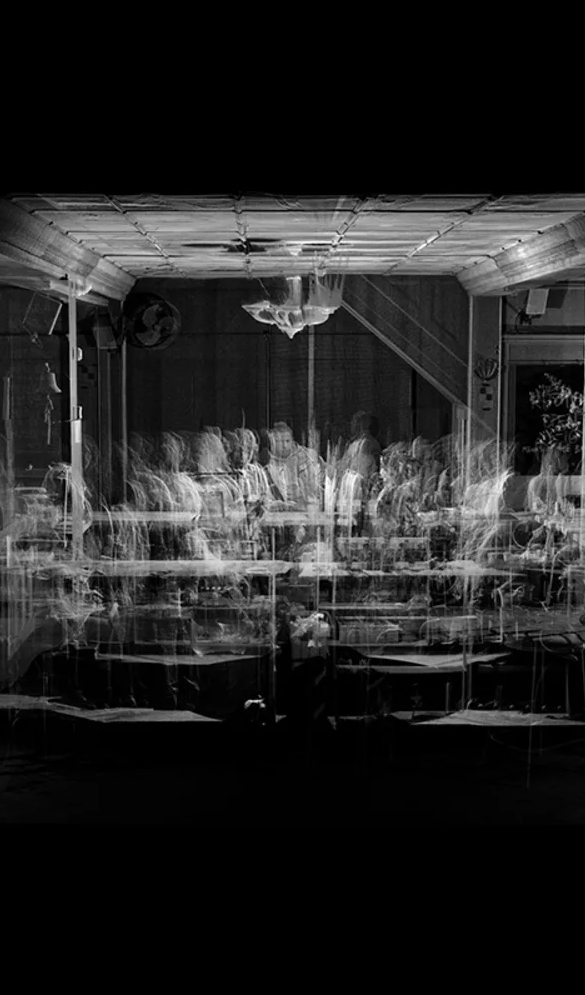
SCANLAB
FRAMERATE
Created from thousands of daily 3D time-lapse scans of British landscapes, the work observes change on a scale impossible to see with the lens of traditional cameras. This is not just an artwork. The data collected and presented by FRAMERATE is ground-breaking scientific research, containing empirical, measurable facts. We glimpse a future perpetually documented by the eyes of a billion autonomous vehicles and personal devices, creating high fidelity spatial records of the earth.

Engineered Arts
AMECA
“Multiply the power of artificial Intelligence with an artificial body. Ameca is the physical presence that brings your code to life. The most advanced lifelike humanoid you can use to develop and show off your greatest machine learning interactions. This robot is the digital interface to the real world.” Engineered Arts
.
“A U.K. robotics firm called Engineered Arts just debuted the first videos of its new humanoid robot, which is able to make hyper-realistic facial expressions. It’s a pretty stunning achievement in the world of robotics; it just also happens to be absolutely terrifying.
Named Ameca, the robot’s face features eyes, cheeks, a mouth, and forehead that contort and change shape to show off emotions ranging from awe to surprise to happiness. One of the new videos of Ameca shows it waking up and seemingly coming to grips with its own existence for the first time ever.” Neel V.Patel

Émilie Brout & Maxime Marion
Lightning Ride
“With Lightning Ride, it is now poles of technology, organics and mysticism that collide with electricity as a connecting point. The video is produced from excerpts of “Taser Certifications”, a sort of ceremony authorizing in the United States the use of Tasers in the condition of being tased by someone else. Filtered with the Photoshop’s “oil painting effect”, slowed down and accompanied by a disturbing soundtrack, the succeeding images show us bodies and faces whose deformations and positions evoke a feeling of pain as well as a Christian ecstacy. Everything unfolds as if the miracle of electricity, symbol of the rationalization of the world, revived paradoxically an aspiration to transcendence, antipodes joining each other and disappearing in profit of a new map of possibilities.” (Sarah Ihler-Meyer)

Liam Young
In the robot skies
In the Robot Skies is the world’s first narrative shot entirely through autonomous drones. In collaboration with the Embedded and Artificially intelligent Vision Lab in Belgium the film has evolved in the context of their experiments with specially developed camera drones each programmed with their own cinematic rules and behaviours. The film explores the drone as a cultural object, not just as a new instrument of visual story telling but also as the catalyst for a new collection of urban sub cultures. In the way the New York subway car of the 80’s gave birth to a youth culture of wild style graffiti and hip hop the age of ubiquitous drones as smart city infrastructure will create a new network of surveillance activists and drone hackers. From the eyes of the drones we see two teenagers each held by police order within the digital confines of their own council estate tower block in London. A network of drones survey the council estates, as a roving flock off cctv cameras and our two characters are kept apart by this autonomous aerial infrastructure.

SOOMI PARK
LED Eyelash
The LED Eyelash project is brought into the world from a simple question: Why do women want larger and bigger eyes? Asian women tend to have stronger needs for bigger eyes as a standard of beauty, but relatively few of them are born with naturally big eyes. Those without big eyes can only look for alternative ways to make their eyes look prettier, i.e., larger, by using a repertoire of skills such as putting on makeup and wearing jewelry. Sometimes, the desires for bigger eyes can become almost obsessive, and many women opt for plastic surgery in order to make their dream come true. Soomi calls this, the fetish of Big Eyes. LED Eyelash is a clever product that speaks to many women’s desire for bigger eyes. It features a sensor to turn on and/or off. The sensor can perceive the movements of the pupil in the eyes and eyelids. If you wear it and move your head, LED Eyelash will flicker following your movements. It is as simple to use as wearing false eyelashes and as easy to remove as taking off a piece of jewelry.

Ryoichi Kurokawa
s.asmbli[wall]
Get immersed by 360° projections on a gigantic cube at OCT Loft Creative Festival and surround yourself with the power of nature. Thanks to a well-chosen combination of front and rear projection screens, you can enjoy the immersive fabric projections from every possible angle. To enhance the immersive 360-feel, several mirrors were placed around the eye-catching sculpture, reflecting the high-quality video mapping beautifully.
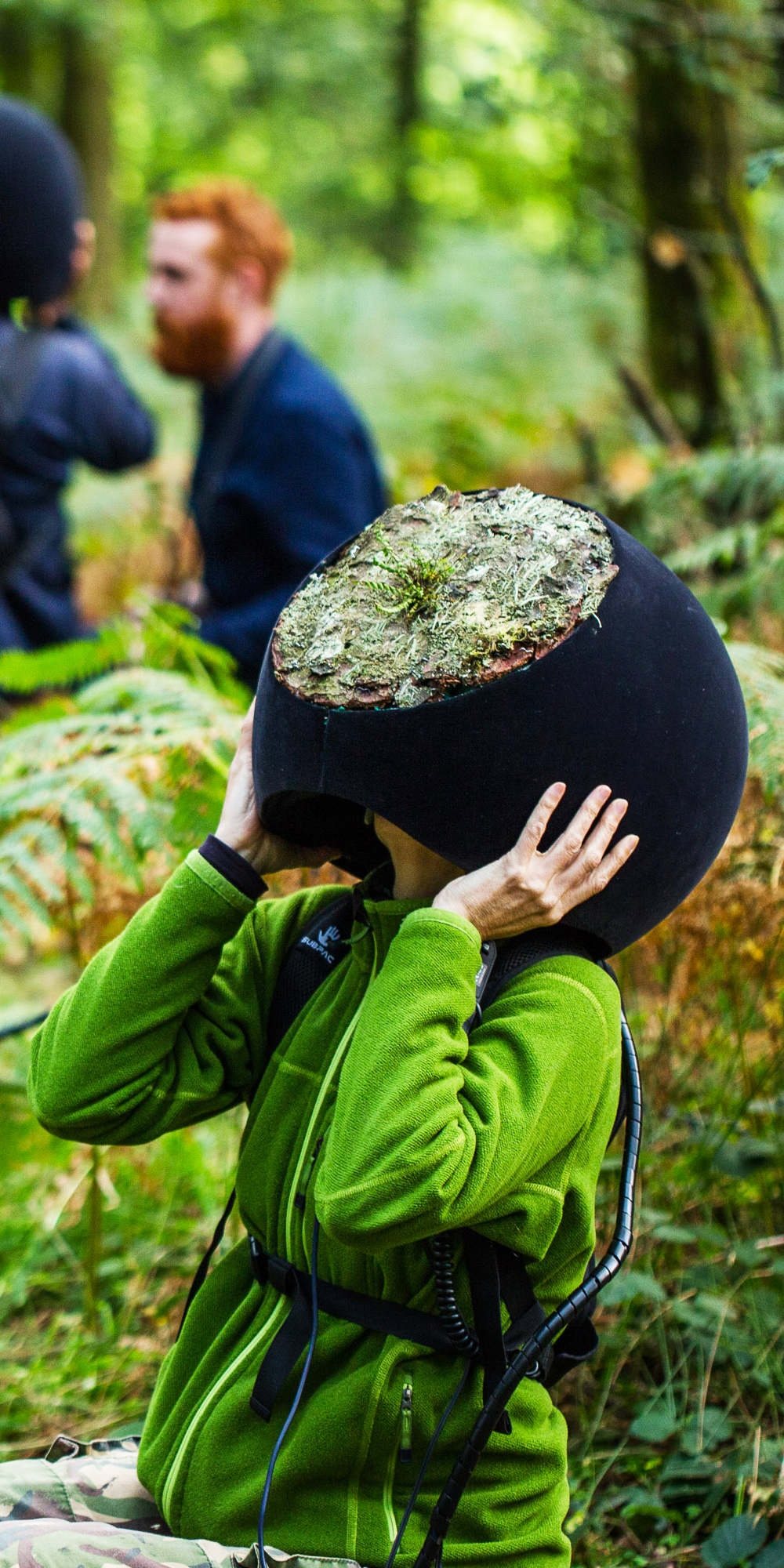
Marshmallow Laser Feast
In the Eyes of the Animal
In the Eyes of the Animal, a journey through the food chain, is an artistic interpretation of the sensory perspectives of three British species. Created using Lidar scans, unmanned aerial vehicles (UAVs) or drones & bespoke 360° cameras, the piece is set to a binaural soundscape using audio recordings sourced from Grizedale Forest in the north of England.

Broersen & Lukács
Point Cloud Old Growth
Forest on Location
In the video work Forest on Location, we see the avatar of the Iranian opera singer Shahram Yazdani walking through a forest. One moment, the forest wraps around him protectively, the next moment the trees crumble away into loose pieces of bark, or melt into a static green mass. At the same time, the forest as a whole floats around in darkness, uprooted. It is a forest without a location, except on our screen. The young man’s avatar appears to be wandering around there aimlessly. It is a wonderland that he exits from towards the end of the video, when his body slips straight through the green wall. This finally breaks the spell of the illusory forest, and everything is revealed to be no more than staged decor. But the forest does exist as a real forest, somewhere. This virtual green world is a digital back-up of Bia?owie?a Forest: the last remaining stretch of primeval low land forest that once covered much of Central Europe. Inspired by what the historian Simon Schama wrote about Bia?owie?a in Landscape and Memory (1995), Persijn Broersen and Margit Lukács journeyed to Poland to capture the forest suffused by old-Germanic nostalgia and mythical atmosphere.

EMILIJA ŠKARNULYTĖ
Mirror Matter
In the neutrino observatory rendered in Mirror Matter, slow panning movement gives a sense of the immensity of the nearly 13,000 photo-multipliers that inhabit this strange vessel – their ‘eyes’ engineered to watch light. Another frame depicts the Hadron Collider at CERN; its architecture envisioned through lidar scans, producing a dynamic, transparent imprint in three dimensions. Described as a vision that flows through the body, it is imagined by Škarnulytė as ‘alien archaeological vision’ with the ability to see through, and as the experience of sight farthest from the human realm. Through simultaneous perspectives, the constant surveying motion that weaves a continues thread through each video narrative, and the immersion generated by the reflective black ceiling, the viewer is imparted with this panoptical mode of perception.

Patricia Olynyk
Oculus
Oculus is a large-scale, collaborative light sculpture that depicts a colossal abstracted drosophila eye, replete with compound faceted surfaces. It both recalls the circular opening at the apex of a cupola and alludes to a surveillance device or drone hovering in mid-air. Oculus is inspired in part by a series of scanning electron micrographs produced in a transgenic lab while researching human and non-human sensoria. The work evokes affective encounters with scale such as viewing miniature particles through the lens of a microscope or wandering through monumental physical environments. As each viewer’s reflection plays across the sculpture’s undulating surface, the apprehension of the self affects both individual and collective behavior in unexpected ways. This affective dynamic plays on the precariousness of our coexistence with other lifeforms in the world, one that is always contingent upon viewers’ bodies and the variability of the environment around them. The act of gazing at Oculus also puts into play the reciprocal condition of both seeing and being seen.

Ani Liu
Eyeris
Eyeris is a cultural prosthetic that renders the user dependent on human touch for sight. While many of today’s digital devices extend our abilities to connect with each other, disability of our current digital devices can been seen through our loss of tangible human interaction. I made this piece in trying to explore the importance of human interdependency in a society living under the myth of autonomy driven by technological symbiosis between man and computer. Eyeris is a mechanically operated electronic device powered by digital input that is deliberately over-engineered to call attention to the social behavioral conditioning imposed on us through less discreet technological devices that we assimilate on a daily basis.

GRINDER-MAN
Mirage
“MIRAGE” is the first performing art ever in the world to experience with immersive. This experience reminds us that we generate ourselves at each moment in our highly subjective ambiguous world. Unlike the general performing arts for the several audiences, “MIRAGE” is generated by the interaction of the two dancers and the one participant. As the participants, you are invited into an 8 minute immersive experience, using a head-mounted display fitted with headphones and a camera to capture live scenes. While unaware of the participant, dancer in front of the eyes is changed over to the dancer that has been recorded in advance. In addition, by overlapping the live scene and recorded ones, participants will experience simultaneous past and present. It is very difficult to tell which dancer is really existing or which is not. Each participant will be required to discover their own “reality”.

Yoon Chung Han
Eyes
Eyes is an interactive art installation and a series of biometric data artworks with my previous artwork Digiti Sonus. It’s an interactive biometric data art that transforms human’s Iris data into musical sound and 3D animated image. The idea is to allow the audience to explore their own identities through unique visual and sound generated by their iris patterns based on iris recognition and image processing techniques. As a part of the installation, selected distinctive iris images are printed in 3D sculptures, and it replays the sound generated from the iris data and projects 3D converted image images. The audience members can compare their iris-based sonic results with others, and question the “problem of disembodied identities’ in the digital era through the existence of audiovisual representations of individuals.

ESTHER STOCKER
ЭСТЕР СТОКЕР
에스더 스토커
以斯帖施特克尔
In addition to painting on the usual canvas, Esther Stocker creates her minimal abstract work on entire rooms and structures. The Italian artist has been creating her black and white installations and wall works since 2001, which have been exhibited all over the world. Esther uses stark geometric lines to create a shaken sense of depth perception and spatial uncertainty in the eyes of the viewer, to which she simply explains: “Control is always what we do not have. This is the human condition.”
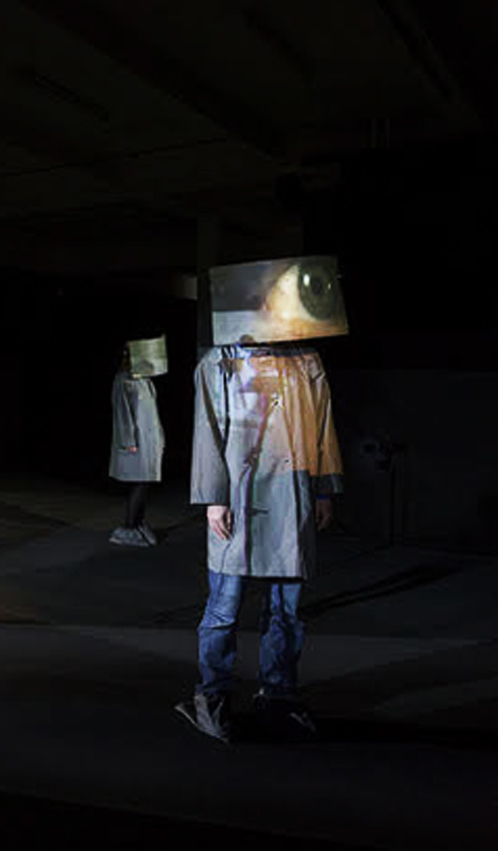
Jacob Taekker
Apophenia Cloud Travel Apparatus
“…a visitor must first gear up in a simple uniform of gray booties, lab coat and adjust a safety-helmet-type harness to their head. This harness supports a grey rectangle of plastic positioned directly in front of one’s face, leaving only the periphery vision for navigation. My first assumption was that this blockage was somehow supposed to simulate an unusual visual disability. However, upon entering the designated darkened room, my ‘screen,’ caught the projection of a giant eye, which filled my vision like some early surrealist film.” Sarrita Hunn

CORNELIA PARKER
كورنيليا باركر
科妮莉亚·帕克
קורנליה פרקר
コーネリア·パーカー
코넬리아 파커
Корнелии Паркер
two rooms
For some years Cornelia Parker’s work has been concerned with formalising things beyond our control, containing the volatile and making it into something that is quiet and contemplative like the ‘eye of the storm’. She is fascinated with processes in the world that mimic cartoon ‘deaths’ – steamrollering, shooting full of holes, falling from cliffs and explosions. Through a combination of visual and verbal allusions her work triggers cultural metaphors and personal associations, which allow the viewer to witness the transformation of the most ordinary objects into something compelling and extraordinary.

RYOICHI KUROKAWA
黒川良一
octfalls
Octfalls consists of eight hanging HD screens displaying images of a silver waterfall cascading down a cliff, while the sound of the water rushing over rocks plays over a pair of speakers attached to each screen. These screens are distributed throughout the space at varying heights, encouraging our eyes to wander freely through the installation. The stunning images and highly refined sounds immerse our senses and play tricks on our perceptions. The waterfall suddenly vanishes in vain, then reappears, shifting to another screen, a complex combination of loops in a unique sequence of orchestrated play.
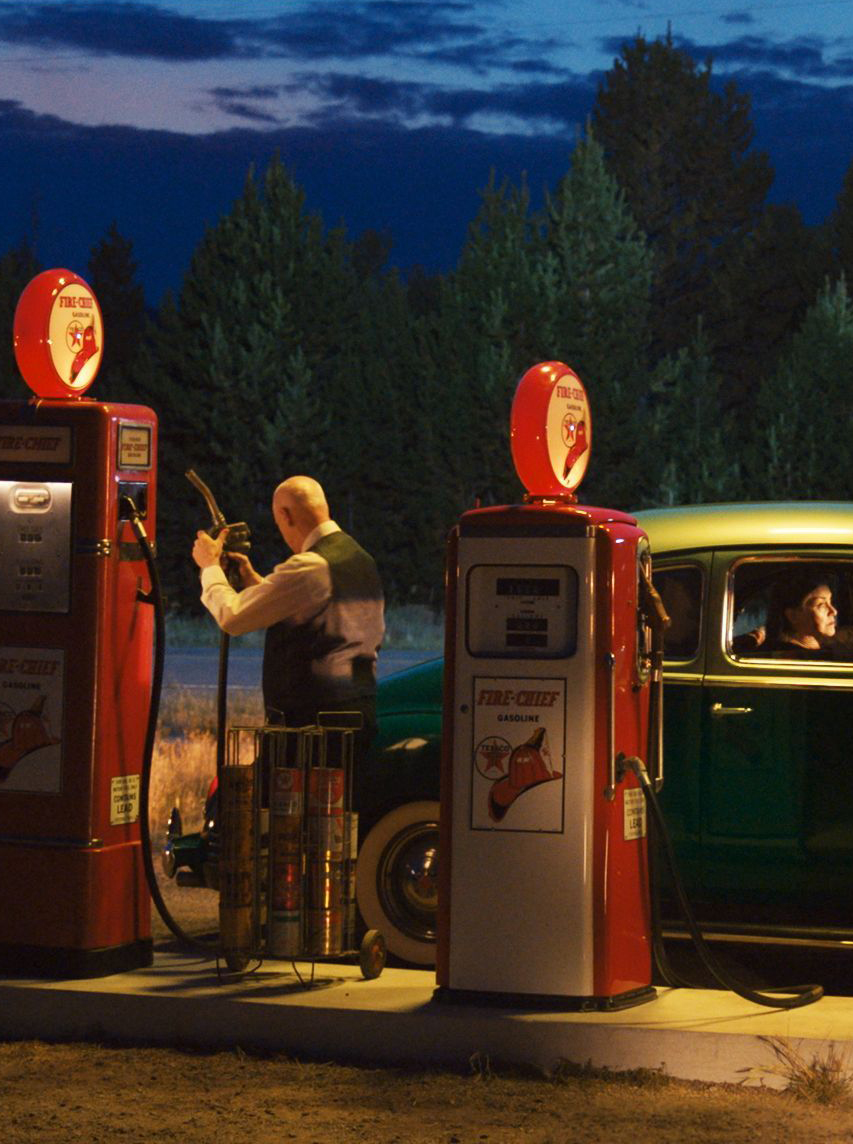
wim wenders
two or three things i know about edward hopper
As part of their spring exhibition Edward Hopper, which focuses on the iconic representations of the infinite expanse of American landscapes and cityscapes of one of the 20th century’s most important American painters, the Fondation Beyeler in Basel will show Wim Wenders’ new 3D film installation.
Organized by the Fondation Beyeler in cooperation with the Whitney Museum of American Art, New York, the major repository of Hopper’s work.

The Constitute: Sebastian Piatza & Christian Zoellner
Eyesect
file festival
”Eyesect” é uma constelação interativa vestível que reflete um experimento extracorpóreo de maneiras imersivas. O trabalho permite que os usuários vicenciem seu ambiente sob novos pontos de vista. O mundo, conforme o percebemos na realidade e por meio da mídia, é alinhado com a visão dos seres humanos através de binóculos e estereoscópio. Essa perspectiva onipresente centrada no humano e o debate crítico sobre a tecnologia 3D que só estimula o espaço real e não simula a ânsia por novas propostas visuais foram o ponto de partida para o trabalho em ”Eyesect”

NANINE LINNING
ZERO
Tanzkompanie Heidelberg
Nanine Linning is responsible for die best niederländischen Choreographers. After the successful performance “Synthetic Twin”, the fiery “Requiem” and the apokalyptic “Voice Over” she is once again going big. ‘ZERO’ is an excitement Crossover, In which Dance, Game, Film, Music and costumes – by Iris van Herpen – ensure that you are short of eyes and ears. Was it born there when the world changed drastically? What are people different in the last hours before everything else? To the spherical music of, among others, Julia Wolf, Ralph Vaughan Williams, Arvo Pärt and Philip Glass phantasieren von Linning und Haarspangen von faszinierenden Ideen.

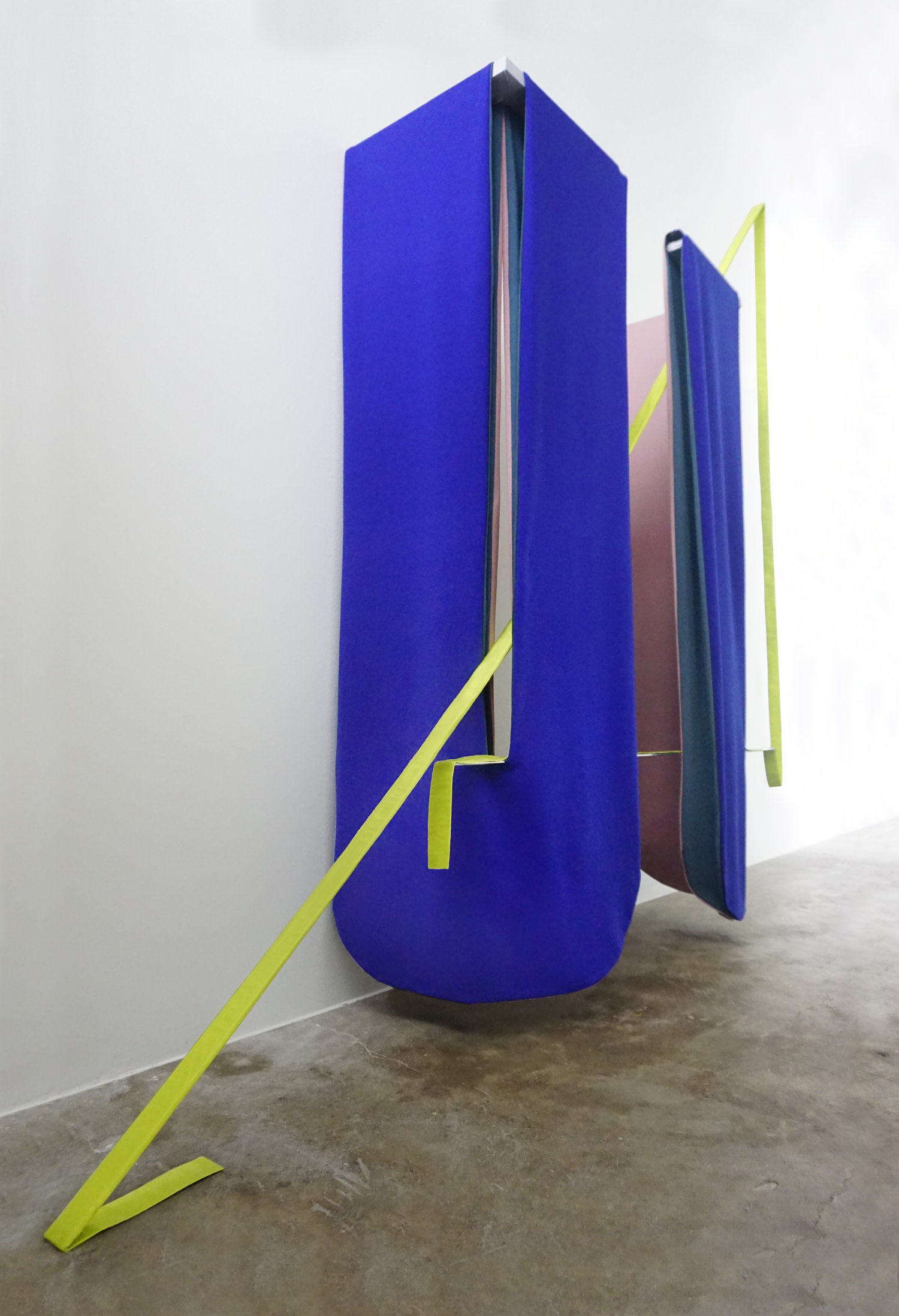
KATY HEINLEIN
Snake Eyes
Katy Heinlein’s exhibition Snake Eyes challenges the sublime possibilities of symmetry, and indulges in the humor, awkwardness, and flustered physicality that comes with disrupting that symmetry. Heinlein fashions pragmatic materials like wood and aluminum into nimble structures, ready to be wrapped and draped in costumes of brightly colored cloth. Like dressing for a night out, the works take on a very human folly: the effort to conceal, emphasize and seduce.

ANDREW HIERONYMI
move
File Festival
MOVE is an interactive installation divided into six distinct modules, JUMP, AVOID, CHASE, THROW, HIDE and COLLECT. Each module offers a single-user interaction, based on a verb corresponding to the action the participant is invited to perform. Each verb corresponds to a common procedure acted out by avatars during videogame play. Each module offers an interaction with abstracted shapes (circles, rectangles) behaving according to simplified rules of physics (collision, friction). Each module is color-coded with consistency, where the color red is used for the graphical element that poses the core challenge. Each module increases difficulty in a similar linear manner.What makes MOVE unusual is that unlike most computer vision or sensor based games like Eye-toy or Dance Dance Revolution, the participant IS the avatar, he is not seeing a representation of herself or an indirect result of her actions on a separate screen but instead interacts directly with the projected graphical constituents of the game. Because those graphical elements are non-representational they do not allow for a projection in a fictional space. The combination of abstracted shapes and direct interaction reinforces in the player the focus on the action itself (JUMP, AVOID, CHASE, THROW, HIDE or COLLECT) instead of an ulterior goal.

Benjamin Sack
Infinite Cityscapes
Sack’s work explores architecture as a flexible medium capable of expressing the unique space between realism and abstraction; where interpretation and our ability to create meaning is in flux. Within this space, Sack, furnished with pen and ink, encapsulates both the infinite and infinitesimal. His work invites the eye to explore drawings of the “big picture,” to gaze into a kaleidoscope of histories and to look further into the elemental world of lines and dots.

